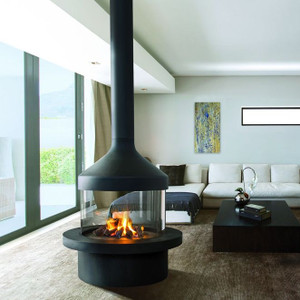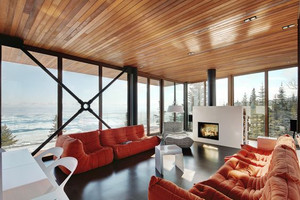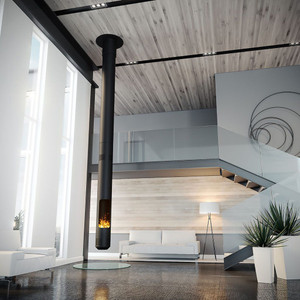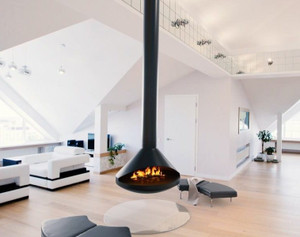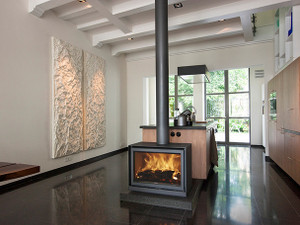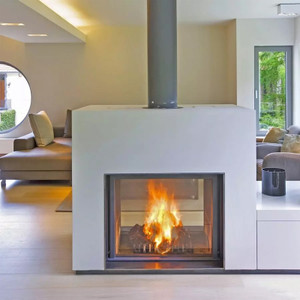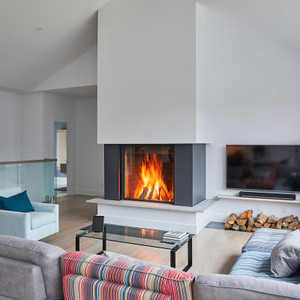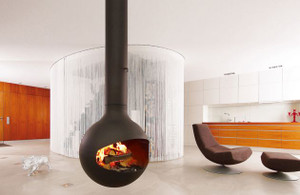
-

-

-

-

-

Stuv 21-125 Clad Double Face Freestanding Fireplace DF2
STUV Contemporary Wood Stoves and Fireplaces
Shop Now -

-

-

-

-

-

-

-

-

-

-

-

-

-

-

-

-

-

-

What is a Wood Fireplace Insert?
A wood fireplace insert, also called a wood stove insert, is basically like a mini wood stove that slides right into your existing fireplace. Think of it as an upgrade for your old fireplace, turning it into a more efficient heat source. Unlike traditional fireplaces that are built into your home’s structure, wood-burning inserts are designed to fit into an existing fireplace without any major construction.
These inserts need to be used in a properly rated fireplace, whether it’s a brick one or an artificial setup. There’s also a frame (called a skirt) that hides the space between the insert and your chimney, making everything look neat and polished. Sometimes, depending on your setup, you might need a flexible liner to adjust the size of your fireplace’s flue. And because these inserts are super efficient, they produce less heat in the exhaust gasses, so a smaller flue is usually needed for everything to work smoothly.
In a nutshell: A wood-burning fireplace is your traditional firebox built from brick or prefab materials, where wood is burned. On the other hand, a wood-burning insert is like a stove that fits inside your fireplace, making it more efficient and better at heating your space. Simple, right?
Is a Wood Burning Fireplace Worth It?
With all the modern heating options like central systems and electric fireplaces, you might be wondering, "Is a wood burning fireplace really worth it?" Honestly, it all comes down to what kind of vibe you want in your home.
There’s just something magical about a wood burning fireplace that you can’t quite match with anything else. The crackle of the flames, the smell of real wood burning, and that cozy warmth create an ambiance that’s hard to beat. It’s not just about heating your space—it’s about the whole experience.
Sure, it’s a bit more effort than just cranking up the thermostat, but for many, that’s part of the charm. You get to connect with nature, tend to the fire, and enjoy a tradition that’s been around forever. Plus, it’s a great way to gather friends and family around for some quality time.
When it comes to cost, wood can actually be cheaper than other heating methods, which makes it a more budget-friendly option in the long run. And the best part? It works even when the power’s out, so with a wood burning fireplace insert, you have a reliable source of heat when you need it. Just keep in mind that there are maintenance costs for the fireplace and chimney, and you’ll need to put in a little time to stock up on wood. But that’s all part of the charm!
Can You Buy a Wood Fireplace?
You can definitely buy wood-burning fireplaces, and the good news is, there’s a style and size to fit just about any home. Many people are after that classic, rustic feel, while some go for a more modern wood burning fireplace.
Here are a few types to think about:
Masonry fireplaces are your traditional beauties made from brick, stone, or concrete. They’ve got that timeless charm and are super durable, not to mention great at holding heat. The downside? They can be a bit pricey to install and need a fair amount of space, so they’re not for every home.
Prefabricated fireplaces, also called factory-built fireplaces, are a more budget-friendly option. These come ready to install and give you a lot of flexibility when it comes to design and location in your home. They’re perfect if you want the look without the heavy construction.
Wood fireplace inserts are a fantastic choice if you’ve already got a fireplace but want to make it more efficient. These inserts slide right into your existing setup and turn it into a high-efficiency heat source—kind of like giving your old fireplace a serious upgrade.
Then there are zero-clearance fireplaces, which are awesome for tight spaces. You can install these right up against walls or other materials without worrying about safety issues. Some of these come with insulated liners for extra protection and efficiency.
You’ve also got freestanding wood stoves and fireplace inserts, which can add a lot of heat and personality to any room.
When buying a wood-burning fireplace, make sure to consider what fits your home’s style and heating needs best. And don’t forget to check local building codes and safety regulations—they’ll help you figure out what’s allowed and what safety measures need to be in place before you light that first fire!
Which Wood Is Best for Fireplaces?
Choosing the right wood for your fireplace makes a huge difference in how well your fire burns, how safe it is, and how much you enjoy those cozy nights by the fire.
Here’s what you need to know:
Hardwoods like oak, maple, and hickory are top picks for wood-burning fireplaces. They burn nice and slow, giving off more heat while producing less creosote (the stuff that can build up in your chimney and cause safety issues). Softwoods like pine and fir, on the other hand, burn faster and can create more creosote, so they’re not the best for long, cozy fires.
Make sure the wood you’re using is well-seasoned. This means it’s been dried out properly for at least a year. Seasoned wood burns cleaner, with less smoke and creosote, and it’s easier to light and keep going. If your wood is freshly cut (or "green"), it’s going to be tough to get it burning well, and it’ll smoke like crazy.
Size matters too! Smaller pieces of wood are easier to ignite and perfect for getting the fire started, while larger logs are better for keeping the heat going. Splitting your wood into smaller pieces also helps with combustion and reduces smoke.
Lastly, steer clear of burning any wood that’s been treated, stained, or painted. That stuff can release harmful chemicals into your home. Go for natural wood, and try to choose something that’s easily available in your area. It’ll save you money on transport and it’s also kinder to the environment!
How to Use a Wood Burning Fireplace
Using a wood burning fireplace doesn’t simply involve tossing in some logs and striking a match. To really get the most out of it—and to stay safe—there are a few important steps to follow. Let’s break it down:
Prep Your Fireplace: First things first, make sure your flue is open (so smoke can escape), the damper is working properly, and the fireplace is clear of old ashes and debris.
Gather Your Gear: Have your firewood, kindling, and fire starters ready to go. Kindling—like dry twigs or some crumpled-up newspaper—helps get the fire going quickly.
Build It Right: Start by placing crumpled newspaper or fire starters at the base of your fireplace. Then add kindling in a teepee or log cabin shape over it. Finally, place a couple of larger logs on top, but don’t overcrowd it—leave space for air to flow.
Light It Up: Using a long match or fireplace lighter, light the newspaper or fire starters. The fire should catch evenly and start spreading through your kindling.
Keep It Going: As the fire burns, add more logs as needed. Just be careful not to overload it—too many logs can choke off the airflow and lead to more smoke than heat. You can also adjust the damper to control how fast or slow the fire burns.
Safety First: Never leave a fire unattended. Use a fireplace screen or glass doors to keep sparks from flying out. Also, make sure you have smoke and carbon monoxide detectors in place, and keep a fire extinguisher nearby just in case.
Maintenance Matters: Keep your fireplace and chimney clean to avoid dangerous creosote buildup. It’s smart to have your chimney inspected and cleaned every year to make sure everything’s safe and running efficiently.
Wood burning fireplaces add a warm, inviting charm to your home. They do take a little effort but that cozy ambiance is totally worth it. Whether you have a masonry fireplace, a prefab model, or a wood insert, the type of wood you use and how you care for your fireplace will make all the difference. Follow these steps, stick to safety guidelines, and you’ll enjoy that crackling warmth for years to come.
How to Install a Wood Burning Fireplace?
Installing a wood-burning fireplace can be a rewarding DIY project but it’s definitely not something to jump into without some prep!
First, you'll need to decide on the location – somewhere with proper ventilation and clearance. The next step is to create a fire-safe hearth base (if you don’t have one already) and make sure the walls around the fireplace are protected. Installing the chimney is where things can get tricky; it’s essential to follow all safety codes and ensure proper venting to prevent dangerous gasses from accumulating indoors.
This is definitely a job where you might want to bring in the pros, especially for the chimney work and making sure your fireplace is safely installed to avoid fire hazards. They can handle all the permits, building codes, and safety checks, giving you peace of mind.
FAQs for Wood Burning Fireplaces
Lighting a wood-burning fireplace is all about building the right base. Start by placing crumpled newspaper or fire starters at the bottom of your fireplace. Then, stack small pieces of kindling (think twigs or small dry sticks) in a crisscross pattern.
Once that’s set, add a couple of medium-sized logs on top. Light the paper or fire starter, and let it burn slowly as the fire catches. Make sure your damper is open for proper ventilation! Just remember, patience is key—don’t rush it or you’ll be battling smoke.
While pine wood is great for campfires, it's not ideal for your indoor fireplace. Pine is a softwood, meaning it burns quickly and produces a lot of resin, which can build up in your chimney over time and create a fire hazard. A lot of people would tell you that the buildup in chimneys is a myth, but that can be very misleading. You can technically use pine wood in your fireplace but you should be prepared for the specific issues that come with it.
Otherwise, stick to hardwoods like oak, maple, or birch, which burn cleaner and last longer. If you do use pine, make sure it’s seasoned (dried out) and only in small amounts!
Mounting a TV above a wood-burning fireplace can look sleek, but it’s not always the best idea. Heat and electronics don’t mix well. If the fireplace gets too hot, it could damage your TV. Plus, the viewing angle might not be ideal.
If you’re set on the idea, make sure to install a mantel to act as a heat shield, and check the manufacturer’s recommendations for heat limits. You should also consult with a professional just to be sure everything's safe and properly installed.
Converting a gas fireplace to a wood-burning one brings back that classic, cozy charm, but it’s not as simple as just swapping out parts. First, you’ll need to check if your gas fireplace was originally built as a wood-burning one (some gas fireplaces can’t handle real wood fires). If it’s safe to convert, the next step is to cap the gas line—this should definitely be done by a professional to avoid any gas leaks or safety hazards. Once that’s done, you’ll need to install or inspect the chimney to ensure it’s properly vented and up to code for burning wood.
This type of project usually requires some permits and inspections, so it’s a good idea to bring in a pro to handle the technical stuff, like removing gas components and making sure your new wood-burning setup meets all safety regulations.

